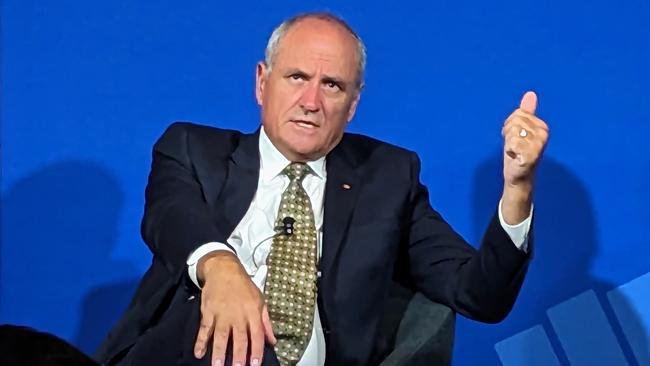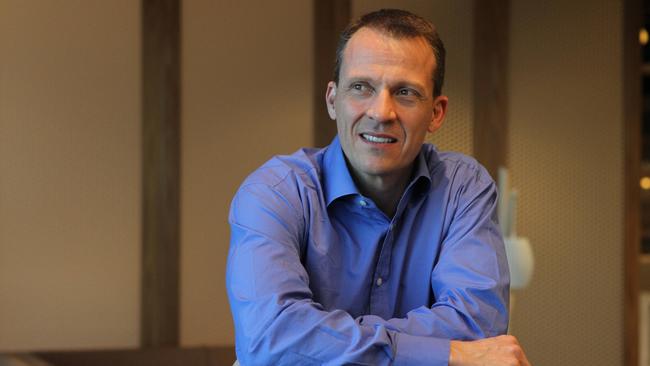Sell-off gives the RBA cause to pause, says former Treasury secretary Ken Henry
Business veteran Ken Henry says Australia’s banks are well protected from global banking volatility but market jitters make the RBA’s rates decision difficult.

Former Treasury secretary and National Australia Bank chair Ken Henry said the Reserve Bank of Australia may have a “moment for pause” before increasing interest rates as central banks evaluate any systemic risks in the market following an emergency funding deal for Credit Suisse.
Dr Henry, who joined NAB’s board in 2011 before serving as its chair between 2015 and 2019, said Silicon Valley Bank’s collapse US and jitters over Credit Suisse would cause central banks to carefully assess further raise rates “but I don’t think they will stop”.
The case for an 11th consecutive rate rise when the RBA meets on April 4 is uncertain. The unemployment rate dropped to 3.5 per cent in February, adding to the case for an increase in the cash rate but bank volatility means traders are factoring in a rate pause in April and a cut by mid year.
Dr Henry told The Australian the capital crunch at SVB, which prompted market intervention and a regulatory backing of deposits of all amounts, was unlikely to occur domestically after a strengthening of bank balance sheets.
“Having said that, the Australian banks have had a better quality of prudential regulation. So I don’t think we should be worrying in Australia,” he said on the sidelines of the Tax Institute’s Financial Services Conference.
Australia’s prudential standards had a far higher “quality and character” than those in the United States. “It’s just so different,” he said.
Bank stocks globally have had a tumultuous week after the demise of SVB and two other US banks, culminating in panic and selling across the sector. Investor concerns midweek about Credit Suisse’s ongoing viability spurred a sharp sell-off in the bank’s shares of as much as 31 per cent, and prompted the Swiss National Bank and the Financial Market Supervisory Authority to intervene.
They told the market they would provide Credit Suisse with liquidity – should it be required – and said there were “no indications of a direct risk of contagion for Swiss institutions” linked to the turmoil in the US banking sector.
“FINMA is in very close contact with the bank and has access to all information relevant to supervisory law. Against this background, FINMA confirms that Credit Suisse meets the higher capital and liquidity requirements applicable to systemically important banks,” the joint regulatory statement said.
On Thursday, Credit Suisse said it would “exercise its option” to borrow up to 50bn Swiss francs under the central bank’s loan and short-term liquidity facility. The bank also flagged it would repurchase certain senior debt securities.
The extreme volatility which was set off by comments that Credit Suisse shareholder Saudi National Bank would not provide the former further financial assistance, also hit Australian-listed bank stocks on Thursday.
Virgin Money’s stock tumbled 4.4 per cent, while investors sent Bendigo and Adelaide Bank’s shares almost 3 per cent lower.
Larger banks fared better with Commonwealth Bank’s stock dipping just 0.1 per cent and National Australia Bank’s shares declining 1.7 per cent.

Despite the global panic, Pendal head of equities Crispin Murray highlighted that Australia’s banking sector was well capitalised and “in good shape”.
“We do have I think a very strong regulatory framework here which ensures we avoid some of the drivers that led to issues in the US,” he said. “It’s a confidence issue.”
Mr Murray expected intervention by regulators and central banks overseas will lead to “some stabilisation” of financial markets.
“These things flare up very quick as they have before. We have very clear support from regulators and central banks and they (conditions) will settle down quickly as well.
“The vast majority of deposits in Australia are backed up by the deposit ($250,000 guarantee) mechanism that we have, and liquidity is much greater here.”
The Reserve Bank’s quarterly bulletin on Thursday highlighted that deposits account for about two thirds of the major banks’ non-equity funding, a figure that has been steady over the past two years. The central bank said, however, tighter monetary policy through last year underpinned a “substantial increase” in bank funding costs.
The RBA is also closely monitoring the shift of hundreds of thousands of loans from ultra-low fixed rate mortgages to markedly higher variable rates this year, and how that impacts consumption and financial stability.
“Aside from encountering a large step up in their loan payments, borrowers on fixed rates tend to have newer loans and, on some measures, more risky loan characteristics than borrowers on variable rates. While the differences are not large in aggregate, more vulnerable borrowers (such as those with lower incomes, more leverage and first home buyers) are more exposed to large increases,” the bulletin said. “The large and discrete increase that borrowers with fixed-rate loans have faced or will soon face in their mortgage payments is one of the factors expected to contribute to slower household consumption in the period ahead. It could ultimately increase the potential for financial stability risks.”
In a note to investors Morgan Stanley banks analyst Richard Wiles highlighted modest risks for Australian banks arising from the collapse of SVB, as he cautioned the turbulence would flow through to wholesale funding costs and pressure margins.
Mr Wiles said Australian banks had learned the lessons of the global financial crisis and had strengthened liquidity and capital buffers and had reduced interest rate risks through hedging.
“Developments in the US banking industry are also likely to cause upward pressure on wholesale funding costs and more competition for stable deposits,” he added.
JP Morgan analysts said the US banking system was facing a 2018-19 repeat scenario, when borrowing rates on unsecured deposits exploded.
In a report to investors the analysts outlined “signs of reserve scarcity in the US” as rates for unsecured borrowers in the funds market had risen “well above” the policy rate.
“The need by the Fed (Federal Reserve) to inject more liquidity into the banking system could become more pressing if the banking system keeps losing deposits to government money market funds,” they said.



To join the conversation, please log in. Don't have an account? Register
Join the conversation, you are commenting as Logout